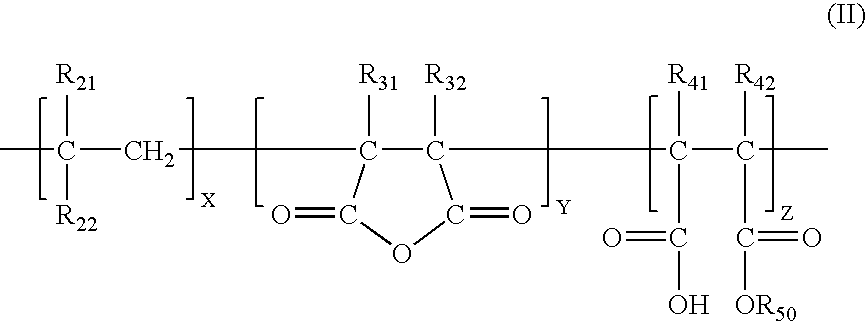Substrate and negative imaging method for providing transparent conducting patterns
- Summary
- Abstract
- Description
- Claims
- Application Information
AI Technical Summary
Benefits of technology
Problems solved by technology
Method used
Image
Examples
example 1
[0107]This example illustrates the formation of a substrate of the invention. The coating composition of Table 1 was coated using a Bushman CN4 coating rod (Bushman Corp., Cleveland Ohio) with a WATERPROOF CV coating system (E.I. DuPont De Nemours, Inc., Wilmington, Del.) onto MELINEX 535 (DuPont-Teijin Films, Hopewell, Va.). The coated base film was dried for 10 min at 45° C. The measured OD at 830 nm was 0.24. The OD throughout the visible range, 400-700 nm, was less than 0.1 at all wavelengths. The thickness of the transparent conducting layer was measured with a Tencor P-15 stylus profilometer (KLA-Tencor, San Jose, Calif.) to be 150 nm. The surface resistance of the conducting layer, was 650 Ohms.
[0108]The peel force for separation of the transparent conducting layer from the base film was measured with an Imass SP-2000 peel tester. The measured peel force was 4300 g per linear inch (1700 g / linear cm) and the failure occurred at the adhesive / glass interface. This demonstrated t...
example 2
[0109]This example illustrates the method for making a transparent conducting pattern.
[0110]The substrate of Example 1 was exposed with near-IR laser light using a CREO Trendsetter exposure unit as described in the methods. The substrate from Example 1 was dried for 60 min at 50° C. The substrate was mounted onto the drum of the exposure unit with the transparent conducting layer facing out from the core of the drum. A receiver consisting of a PET film (2 mil, 0.05 mm) containing Solvent Green 28 dye, as disclosed in the materials section, was loaded second. Films were mounted using vacuum hold down to a standard plastic or metal carrier plate clamped mechanically to the drum. The assemblage was exposed in selected regions at 18 W at 830 nm at a drum speed of 60 rpm from the side through the receiver.
[0111]The pattern that was exposed to the imaging laser consisted of a contiguous exposed region such that the unexposed regions comprised a set of about 50 lines that were 1 mm wide by...
example 3
[0112]This example illustrates the method for making a patterned substrate having a transparent conducting pattern and a second conducting pattern.
[0113]A metal composition comprising Ag flake was first prepared using the materials listed in Table 2. The composition was mixed in a vial with an ultrasound probe (Dukane Co., Model 40TP2000, Transducer Model 41C28) for 15 min, during which the mixture was stirred with a spatula at 5 min intervals. The vial was placed in a water bath with sonication for 1 h, during which the mixture was stirred with a spatula at 0.5 h intervals. The mixture was then treated in a water bath at RT with probe sonication for an additional 15 min, during which the mixture was stirred with a spatula at 5 min intervals. The resulting dispersion was filtered twice through an 8 micron stainless steel screen (Twill Dutch Weave 325×2300, Sefar America Inc.).
TABLE 2Metal Composition for Metal Transfer LayerMaterialWeight (g)SF 69 flake Ag24.015DI water12.7JONCRYL 5...
PUM
 Login to View More
Login to View More Abstract
Description
Claims
Application Information
 Login to View More
Login to View More - R&D
- Intellectual Property
- Life Sciences
- Materials
- Tech Scout
- Unparalleled Data Quality
- Higher Quality Content
- 60% Fewer Hallucinations
Browse by: Latest US Patents, China's latest patents, Technical Efficacy Thesaurus, Application Domain, Technology Topic, Popular Technical Reports.
© 2025 PatSnap. All rights reserved.Legal|Privacy policy|Modern Slavery Act Transparency Statement|Sitemap|About US| Contact US: help@patsnap.com


